Esmé Raji Codell's Blog, page 8
September 7, 2011
HORNBOOKS AND INKWELLS (NONFICTION)
Book du Jour:HORNBOOKS AND INKWELLS by Verla Kay, illustrated by S.D. Schindler (Putnam)
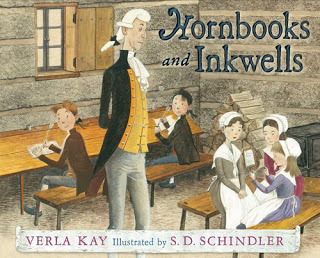
A trip to an 18th-century one-room schoolhouse in a book, through the magic of terse verse and good-humored pictures! How about wearing neck yokes for punishment, or ice-skating at recess, or bathroom in the outhouse? Yeesh, makes young 'uns today look rather milquetoast. The terse verse is brought to life through the good-humored, detailed drawings, fittingly fettered with straight lines. Let's write "we love Schindler's mannered illustrations" 100 times, in our best handwriting. A perfect preface for another historical schoolroom story, Avi's THE SECRET SCHOOL, in which a fourteen-year old girl in 1925 gets to work behind the teacher's desk, or Laura Ingall's Wilder's amazing depiction of 19th century school life in LITTLE TOWN ON THE PRAIRIE. You tell your readers, "When I was a kid, I had to walk two miles uphill in a snowstorm to get to school to read these books, and you get to take the bus to the library!" That'll learn 'im. (8 and up)
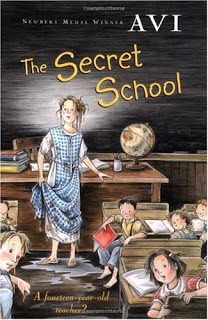

Links are provided for informational use. Don't forget to support your local bookseller.
More Esmé stuff at www.planetesme.com.


A trip to an 18th-century one-room schoolhouse in a book, through the magic of terse verse and good-humored pictures! How about wearing neck yokes for punishment, or ice-skating at recess, or bathroom in the outhouse? Yeesh, makes young 'uns today look rather milquetoast. The terse verse is brought to life through the good-humored, detailed drawings, fittingly fettered with straight lines. Let's write "we love Schindler's mannered illustrations" 100 times, in our best handwriting. A perfect preface for another historical schoolroom story, Avi's THE SECRET SCHOOL, in which a fourteen-year old girl in 1925 gets to work behind the teacher's desk, or Laura Ingall's Wilder's amazing depiction of 19th century school life in LITTLE TOWN ON THE PRAIRIE. You tell your readers, "When I was a kid, I had to walk two miles uphill in a snowstorm to get to school to read these books, and you get to take the bus to the library!" That'll learn 'im. (8 and up)


Links are provided for informational use. Don't forget to support your local bookseller.
More Esmé stuff at www.planetesme.com.
Published on September 07, 2011 19:01
August 26, 2011
WON TON: A CAT TALE TOLD IN HAIKU
POETRY
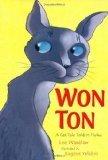 WON TON
WON TON : A CAT TALE TOLD IN HAIKU by Lee Wardlaw, illustrated by Eugene Yelchin (Henry Holt)
: A CAT TALE TOLD IN HAIKU by Lee Wardlaw, illustrated by Eugene Yelchin (Henry Holt)
All right. So far in the past year or so I've seen GUYKU , DOGKU
, DOGKU , WABI SABI
, WABI SABI and THE HOUND DOG'S HAIKU
and THE HOUND DOG'S HAIKU , and the hard-to-find , and I like checking book reviews on EmilyReads (try that for a book report!), all amicable thematic treatments of the 5-7-5 poetic syllabic form that is haiku, but plentiful offerings all the same, so I hope you will excuse me if I wondered if this latest had anything new and worthwhile to add. Mee-wow, what sets this one apart is its lovely story arc, as a mysterious Siamese is adopted from an animal shelter and undergoes the indignity of being named:
, and the hard-to-find , and I like checking book reviews on EmilyReads (try that for a book report!), all amicable thematic treatments of the 5-7-5 poetic syllabic form that is haiku, but plentiful offerings all the same, so I hope you will excuse me if I wondered if this latest had anything new and worthwhile to add. Mee-wow, what sets this one apart is its lovely story arc, as a mysterious Siamese is adopted from an animal shelter and undergoes the indignity of being named:
Won Ton? How can Ibe soup? Some day, I'll tell youmy real name. Maybe.
After this feline stretches and claws his way most fetchingly across the pages, deciding inconstantly whether to be in and out of dresses (or yards or cars or under the couch), leaving presents in shoes and finding resting places in socks and on tummies, the pet's real name is revealed; one we should have guessed all along. In a few short pages and in shorter lines, the author and illustrator conspire to create a strong characterization of what starts out as a cat and ends as a member of the family. By the last page, this pet is bonded both to his owner and to us, his readers. What started out as "not another cat book!" ended with "this is not just another cat book," a unique addition to a collection and an excellent storytime read-aloud to boot. (6 and up)
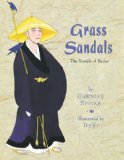 With the plethora of haiku books available and the propensity for teachers to let students try the format on for size, please also do consider sharing Demi's biographical picture book GRASS SANDALS: THE TRAVELS OF BASHO
With the plethora of haiku books available and the propensity for teachers to let students try the format on for size, please also do consider sharing Demi's biographical picture book GRASS SANDALS: THE TRAVELS OF BASHO , and COOL MELONS, TURN TO FROGS! THE LIFE AND POEMS OF ISSA
, and COOL MELONS, TURN TO FROGS! THE LIFE AND POEMS OF ISSA  by Matthew Golub, illustrated by Kazuko Stone (more of Issa's poems in TODAY AND TODAY
by Matthew Golub, illustrated by Kazuko Stone (more of Issa's poems in TODAY AND TODAY illustrated by G. Brian Karas), lest we forget that the format, while short, is far from flippant, requiring a concerted attunement to nature and a thoughtful economy of words that represents real craft.
illustrated by G. Brian Karas), lest we forget that the format, while short, is far from flippant, requiring a concerted attunement to nature and a thoughtful economy of words that represents real craft.
Also of interest:Remember, every month can be poetry month! Here are more excellent poetry books with a sense of play.
 LEMONADE AND OTHER POEMS SQUEEZED FROM A SINGLE WORD
LEMONADE AND OTHER POEMS SQUEEZED FROM A SINGLE WORD 
 by Bob Raczka, illustrated by Nancy Doniger (Roaring Brook)
by Bob Raczka, illustrated by Nancy Doniger (Roaring Brook)
This book promises "part anagram, part rebus, part riddle," and delivers, by inventively rearranging letters from one potent word to create a whole poem:
"Moonlight"
hot
night
thin
light
moth
in
motion
or how about "Spaghetti?"
papa
has
a
pasta
appetite
he
eats
heaps
Wait, wait, one more! "Television!"
set
is
on
I
sit
 Each page depicts the letters falling down the page a la cousin to the concrete poem (see Paul Janeczko's A POKE IN THE I
Each page depicts the letters falling down the page a la cousin to the concrete poem (see Paul Janeczko's A POKE IN THE I  for more on that), inviting the reader to decode the clever text which is clearly revealed with minimalist force on the following page. Not since the board game Scrabble or Marilyn Singer's MIRROR MIRROR: A BOOK OF REVERSIBLE VERSE has there been such a fresh squeeze
for more on that), inviting the reader to decode the clever text which is clearly revealed with minimalist force on the following page. Not since the board game Scrabble or Marilyn Singer's MIRROR MIRROR: A BOOK OF REVERSIBLE VERSE has there been such a fresh squeeze on language, and with over twenty examples, how can we resist trying our own? Maybe using the word "September" for a first day start? Or "Homework?" (All right, maybe not homework.) (7 and up)
on language, and with over twenty examples, how can we resist trying our own? Maybe using the word "September" for a first day start? Or "Homework?" (All right, maybe not homework.) (7 and up)
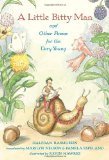 A LITTLE BITTY MAN AND OTHER POEMS FOR THE VERY YOUNG
A LITTLE BITTY MAN AND OTHER POEMS FOR THE VERY YOUNG
 by Halfdan Rasmussen, illustrated by Kevin Hawkes (Candlewick) Published post-mortem by the award-winning Danish children's poet, how can I not recommend a book of verse with the kind of joyful lilt that I imagine would have been right at home in Margaret Wise Brown's classroom collection? A bit more fanciful, though...for example, "The Elf":
by Halfdan Rasmussen, illustrated by Kevin Hawkes (Candlewick) Published post-mortem by the award-winning Danish children's poet, how can I not recommend a book of verse with the kind of joyful lilt that I imagine would have been right at home in Margaret Wise Brown's classroom collection? A bit more fanciful, though...for example, "The Elf":
The elf puts on his winter coatand puts his winter hat on,finds a muffler for his throatin his drawer--puts that on,packs his pockets full of miceand then, before he goes,puts on a empty ice-cream coneto insulate his nose.
and lines from the title poem, "A Little Bitty Man":
The little bitty manbought a little bitty housefor a little bit of little bitty money.The little bitty ladygrew very, very bigwith a little bitty baby in her tummy.
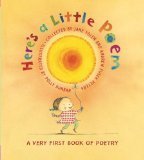 Hawkes' illustrations, wonderful and jocular as ever (WESLANDIA
Hawkes' illustrations, wonderful and jocular as ever (WESLANDIA , LIBRARY LION), might unfortunately be just a wee bit visually small and detailed to be considered a perfect developmental match for "the very young" to which the book is ascribed (see Polly Dunbar's broader strokes and bigger pages in Jane Yolen's HERE'S A LITTLE POEM: A VERY FIRST BOOK OF POETRY
, LIBRARY LION), might unfortunately be just a wee bit visually small and detailed to be considered a perfect developmental match for "the very young" to which the book is ascribed (see Polly Dunbar's broader strokes and bigger pages in Jane Yolen's HERE'S A LITTLE POEM: A VERY FIRST BOOK OF POETRY
 to know what I mean), but this book still is perfectly endearing on its own terms. It offers invigoration to a tired nursery rhyme repertoire, works well for laptime, and has both a visual and verbal humor throughout with room to grow into, even if you are an itty bitty boy or girl. (3 and up)
to know what I mean), but this book still is perfectly endearing on its own terms. It offers invigoration to a tired nursery rhyme repertoire, works well for laptime, and has both a visual and verbal humor throughout with room to grow into, even if you are an itty bitty boy or girl. (3 and up)
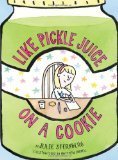 LIKE PICKLE JUICE ON A COOKIE
LIKE PICKLE JUICE ON A COOKIE
 by Julie Sternberg, illustrated by Matthew Cordell (Amulet)
by Julie Sternberg, illustrated by Matthew Cordell (Amulet)
When Bibi the babysitter has to move away from her job in order to care for her ailing father in Florida, it represents a major loss for Eleanor, who has counted on her all her life. Starting a school year and transitioning into many more new relationships is part of growing up, Eleanor discovers, as is letting go...at least a little bit. Cordell, (no relation and with an "R" in his name) is always an illustrator to watch, and uses line drawings as direct as Eleanor's emotions. There is a clarity and honesty in everything about this book, and children, even if the situation is not one they share, will appreciate the gravity with which Eleanor's situation is treated, and the high note of hope on which the story ends.. Meanwhile,we in the market can appreciate a thematically-appropriate tome for pre-teen readers (thank you very much, more, please!).
Okay, here's what I don't exactly "get." My brilliant high school English teacher advised us once that good prose should read in parts like poetry, as if it could be broken down into lines. There are a lot of narratives that are formatted into lines of poetry (REACHING FOR THE SUN , JAKE AND MINN
, JAKE AND MINN ), and LIKE PICKLE JUICE, too, is one. My question is, if my English teacher was right (as she has always been so far), then why? Why don't the authors just tell a prosaic tale with lines that read like poetry? When is a realistic story suddenly compelled into the arrangement of free verse? Is it just a feeling? What would be lost by more conventional structure on a page? What makes poetry poetry? Perhaps there is no right answer, but that, mes amis, is a worthwhile discussion... another teachable moment offered by this sensitive book. (8 and up)
), and LIKE PICKLE JUICE, too, is one. My question is, if my English teacher was right (as she has always been so far), then why? Why don't the authors just tell a prosaic tale with lines that read like poetry? When is a realistic story suddenly compelled into the arrangement of free verse? Is it just a feeling? What would be lost by more conventional structure on a page? What makes poetry poetry? Perhaps there is no right answer, but that, mes amis, is a worthwhile discussion... another teachable moment offered by this sensitive book. (8 and up)
Links are provided for informational use. Don't forget to support your local bookseller.
More Esmé stuff at www.planetesme.com.

 WON TON
WON TON : A CAT TALE TOLD IN HAIKU by Lee Wardlaw, illustrated by Eugene Yelchin (Henry Holt)
: A CAT TALE TOLD IN HAIKU by Lee Wardlaw, illustrated by Eugene Yelchin (Henry Holt) All right. So far in the past year or so I've seen GUYKU
 , DOGKU
, DOGKU , WABI SABI
, WABI SABI and THE HOUND DOG'S HAIKU
and THE HOUND DOG'S HAIKU , and the hard-to-find , and I like checking book reviews on EmilyReads (try that for a book report!), all amicable thematic treatments of the 5-7-5 poetic syllabic form that is haiku, but plentiful offerings all the same, so I hope you will excuse me if I wondered if this latest had anything new and worthwhile to add. Mee-wow, what sets this one apart is its lovely story arc, as a mysterious Siamese is adopted from an animal shelter and undergoes the indignity of being named:
, and the hard-to-find , and I like checking book reviews on EmilyReads (try that for a book report!), all amicable thematic treatments of the 5-7-5 poetic syllabic form that is haiku, but plentiful offerings all the same, so I hope you will excuse me if I wondered if this latest had anything new and worthwhile to add. Mee-wow, what sets this one apart is its lovely story arc, as a mysterious Siamese is adopted from an animal shelter and undergoes the indignity of being named:Won Ton? How can Ibe soup? Some day, I'll tell youmy real name. Maybe.
After this feline stretches and claws his way most fetchingly across the pages, deciding inconstantly whether to be in and out of dresses (or yards or cars or under the couch), leaving presents in shoes and finding resting places in socks and on tummies, the pet's real name is revealed; one we should have guessed all along. In a few short pages and in shorter lines, the author and illustrator conspire to create a strong characterization of what starts out as a cat and ends as a member of the family. By the last page, this pet is bonded both to his owner and to us, his readers. What started out as "not another cat book!" ended with "this is not just another cat book," a unique addition to a collection and an excellent storytime read-aloud to boot. (6 and up)
 With the plethora of haiku books available and the propensity for teachers to let students try the format on for size, please also do consider sharing Demi's biographical picture book GRASS SANDALS: THE TRAVELS OF BASHO
With the plethora of haiku books available and the propensity for teachers to let students try the format on for size, please also do consider sharing Demi's biographical picture book GRASS SANDALS: THE TRAVELS OF BASHO , and COOL MELONS, TURN TO FROGS! THE LIFE AND POEMS OF ISSA
, and COOL MELONS, TURN TO FROGS! THE LIFE AND POEMS OF ISSA  by Matthew Golub, illustrated by Kazuko Stone (more of Issa's poems in TODAY AND TODAY
by Matthew Golub, illustrated by Kazuko Stone (more of Issa's poems in TODAY AND TODAY illustrated by G. Brian Karas), lest we forget that the format, while short, is far from flippant, requiring a concerted attunement to nature and a thoughtful economy of words that represents real craft.
illustrated by G. Brian Karas), lest we forget that the format, while short, is far from flippant, requiring a concerted attunement to nature and a thoughtful economy of words that represents real craft. Also of interest:Remember, every month can be poetry month! Here are more excellent poetry books with a sense of play.
 LEMONADE AND OTHER POEMS SQUEEZED FROM A SINGLE WORD
LEMONADE AND OTHER POEMS SQUEEZED FROM A SINGLE WORD 
 by Bob Raczka, illustrated by Nancy Doniger (Roaring Brook)
by Bob Raczka, illustrated by Nancy Doniger (Roaring Brook)This book promises "part anagram, part rebus, part riddle," and delivers, by inventively rearranging letters from one potent word to create a whole poem:
"Moonlight"
hot
night
thin
light
moth
in
motion
or how about "Spaghetti?"
papa
has
a
pasta
appetite
he
eats
heaps
Wait, wait, one more! "Television!"
set
is
on
I
sit
 Each page depicts the letters falling down the page a la cousin to the concrete poem (see Paul Janeczko's A POKE IN THE I
Each page depicts the letters falling down the page a la cousin to the concrete poem (see Paul Janeczko's A POKE IN THE I  for more on that), inviting the reader to decode the clever text which is clearly revealed with minimalist force on the following page. Not since the board game Scrabble or Marilyn Singer's MIRROR MIRROR: A BOOK OF REVERSIBLE VERSE has there been such a fresh squeeze
for more on that), inviting the reader to decode the clever text which is clearly revealed with minimalist force on the following page. Not since the board game Scrabble or Marilyn Singer's MIRROR MIRROR: A BOOK OF REVERSIBLE VERSE has there been such a fresh squeeze on language, and with over twenty examples, how can we resist trying our own? Maybe using the word "September" for a first day start? Or "Homework?" (All right, maybe not homework.) (7 and up)
on language, and with over twenty examples, how can we resist trying our own? Maybe using the word "September" for a first day start? Or "Homework?" (All right, maybe not homework.) (7 and up) A LITTLE BITTY MAN AND OTHER POEMS FOR THE VERY YOUNG
A LITTLE BITTY MAN AND OTHER POEMS FOR THE VERY YOUNG
 by Halfdan Rasmussen, illustrated by Kevin Hawkes (Candlewick) Published post-mortem by the award-winning Danish children's poet, how can I not recommend a book of verse with the kind of joyful lilt that I imagine would have been right at home in Margaret Wise Brown's classroom collection? A bit more fanciful, though...for example, "The Elf":
by Halfdan Rasmussen, illustrated by Kevin Hawkes (Candlewick) Published post-mortem by the award-winning Danish children's poet, how can I not recommend a book of verse with the kind of joyful lilt that I imagine would have been right at home in Margaret Wise Brown's classroom collection? A bit more fanciful, though...for example, "The Elf":The elf puts on his winter coatand puts his winter hat on,finds a muffler for his throatin his drawer--puts that on,packs his pockets full of miceand then, before he goes,puts on a empty ice-cream coneto insulate his nose.
and lines from the title poem, "A Little Bitty Man":
The little bitty manbought a little bitty housefor a little bit of little bitty money.The little bitty ladygrew very, very bigwith a little bitty baby in her tummy.
 Hawkes' illustrations, wonderful and jocular as ever (WESLANDIA
Hawkes' illustrations, wonderful and jocular as ever (WESLANDIA , LIBRARY LION), might unfortunately be just a wee bit visually small and detailed to be considered a perfect developmental match for "the very young" to which the book is ascribed (see Polly Dunbar's broader strokes and bigger pages in Jane Yolen's HERE'S A LITTLE POEM: A VERY FIRST BOOK OF POETRY
, LIBRARY LION), might unfortunately be just a wee bit visually small and detailed to be considered a perfect developmental match for "the very young" to which the book is ascribed (see Polly Dunbar's broader strokes and bigger pages in Jane Yolen's HERE'S A LITTLE POEM: A VERY FIRST BOOK OF POETRY
 to know what I mean), but this book still is perfectly endearing on its own terms. It offers invigoration to a tired nursery rhyme repertoire, works well for laptime, and has both a visual and verbal humor throughout with room to grow into, even if you are an itty bitty boy or girl. (3 and up)
to know what I mean), but this book still is perfectly endearing on its own terms. It offers invigoration to a tired nursery rhyme repertoire, works well for laptime, and has both a visual and verbal humor throughout with room to grow into, even if you are an itty bitty boy or girl. (3 and up) LIKE PICKLE JUICE ON A COOKIE
LIKE PICKLE JUICE ON A COOKIE
 by Julie Sternberg, illustrated by Matthew Cordell (Amulet)
by Julie Sternberg, illustrated by Matthew Cordell (Amulet)When Bibi the babysitter has to move away from her job in order to care for her ailing father in Florida, it represents a major loss for Eleanor, who has counted on her all her life. Starting a school year and transitioning into many more new relationships is part of growing up, Eleanor discovers, as is letting go...at least a little bit. Cordell, (no relation and with an "R" in his name) is always an illustrator to watch, and uses line drawings as direct as Eleanor's emotions. There is a clarity and honesty in everything about this book, and children, even if the situation is not one they share, will appreciate the gravity with which Eleanor's situation is treated, and the high note of hope on which the story ends.. Meanwhile,we in the market can appreciate a thematically-appropriate tome for pre-teen readers (thank you very much, more, please!).
Okay, here's what I don't exactly "get." My brilliant high school English teacher advised us once that good prose should read in parts like poetry, as if it could be broken down into lines. There are a lot of narratives that are formatted into lines of poetry (REACHING FOR THE SUN
 , JAKE AND MINN
, JAKE AND MINN ), and LIKE PICKLE JUICE, too, is one. My question is, if my English teacher was right (as she has always been so far), then why? Why don't the authors just tell a prosaic tale with lines that read like poetry? When is a realistic story suddenly compelled into the arrangement of free verse? Is it just a feeling? What would be lost by more conventional structure on a page? What makes poetry poetry? Perhaps there is no right answer, but that, mes amis, is a worthwhile discussion... another teachable moment offered by this sensitive book. (8 and up)
), and LIKE PICKLE JUICE, too, is one. My question is, if my English teacher was right (as she has always been so far), then why? Why don't the authors just tell a prosaic tale with lines that read like poetry? When is a realistic story suddenly compelled into the arrangement of free verse? Is it just a feeling? What would be lost by more conventional structure on a page? What makes poetry poetry? Perhaps there is no right answer, but that, mes amis, is a worthwhile discussion... another teachable moment offered by this sensitive book. (8 and up)Links are provided for informational use. Don't forget to support your local bookseller.
More Esmé stuff at www.planetesme.com.
Published on August 26, 2011 18:11
May 1, 2011
CINNAMON BABY (PICTURE BOOK)
PICTURE BOOK
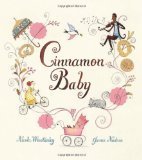 CINNAMON BABY
CINNAMON BABY  by Nicola Winstanley, illustrated by Janice Nadeau (Kids Can Press)
by Nicola Winstanley, illustrated by Janice Nadeau (Kids Can Press)
LOVE love love love LOVE love LOOOVE, what could be more romantic than a family? And that's exactly what comes about after Sebastian the violinist falls for Miriam the baker. But alas, for all the affection in the family house, their baby won't stop crying like crazy. It isn't until Mama Miriam bakes every loaf in the cookbook that the baby recognizes the warm and sugary-sweet smell remembered from time spent cooking in the oven of the womb. Collage and curlicued watercolor lines wend through the pages, graceful as filigree. The illustration of all three cozied up on a family bed, and Miriam wandering worried (and maybe a little embarrassed?) on a walk while the baby's wails inspire the opening of umbrellas to protect from tears, are recognizable and human. Descriptions of Miriam's bounty ("She made a spicy bread, studded with little peppercorns and basil, and a sweet bread with ginger. She made a light, white loaf with dill, and a crusty brown one with sunflower seeds and honey") add to the feeling of warmth and plenty that abound in these pages. Romantic and readable, this pretty pick is a stand-out also because of its natural depiction of a bi-racial family in the context of a story that any child can enjoy. What a treat. (4 and up)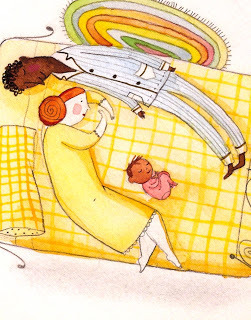 Also of interest:More fun with baked goods.
Also of interest:More fun with baked goods.
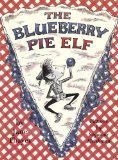 THE BLUEBERRY PIE ELF by Jane Thayer, illustrated by Seymour Fleischman (Purple House Press)
THE BLUEBERRY PIE ELF by Jane Thayer, illustrated by Seymour Fleischman (Purple House Press)
It is so delicious when a vintage children's book is properly reprinted. First published in 1959, we are allowed to revisit the magical story of an invisible elf who savors a bite of a family's blueberry pie, but has no way to ask for seconds. Hoping beyond hope that they will be encouraged to bake another one, he tries helping around the house, to no avail. When the family sets out less desirable cherry and apple pies, the poor elf can barely contain his disappointment. But with a little help from the tracks he leaves from his tiny elfin shoes, after tasting lesser pies, he realizes what all good readers know: writing can make all the difference. The elf is gracious through all of his frustrations, and if you have a taste for a story is sweet and straightforward, this is a little slice of heaven. (4 and up)
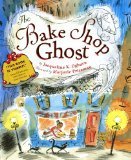
 THE BAKE SHOP GHOST by Jacqueline Ogburn, illustrated by Marjorie A. Priceman (Houghton Mifflin)
THE BAKE SHOP GHOST by Jacqueline Ogburn, illustrated by Marjorie A. Priceman (Houghton Mifflin)
Cora Lee Merriweather bakes such delicious pies and cakes, her bake shop customers are willing to forgive the fact that every bit of sweetness seems to go into her work. When mean Madame Merriweather finally gives up the ghost, that's all she's willing to give up. As a prankish poltergeist, she successfully drives away anyone who seeks to inhabit her former kitchen, but when former cruise ship pastry chef Annie Washington rents the storefront, it is going to take more than a little flying flour to drive her out. When Annie finally asks what she can do for Cora Lee to settle her spirit, she says, "Make me a cake so rich and so sweet, it will fill me up and bring tears to my eyes. A cake like the one I might have baked, but no one ever made for me." Will Annie spend the rest of her life trying to bake this magical cake, or will she find the bittersweet ingredient that will free them both? Superb storytelling and ebullient illustrations are a recipe for read-aloud in this perfectly delicious ghost story about empathy and cooperation. (7 and up)
Links are provided for informational use. Don't forget to support your local bookseller.
More Esmé stuff at www.planetesme.com.

 CINNAMON BABY
CINNAMON BABY  by Nicola Winstanley, illustrated by Janice Nadeau (Kids Can Press)
by Nicola Winstanley, illustrated by Janice Nadeau (Kids Can Press)LOVE love love love LOVE love LOOOVE, what could be more romantic than a family? And that's exactly what comes about after Sebastian the violinist falls for Miriam the baker. But alas, for all the affection in the family house, their baby won't stop crying like crazy. It isn't until Mama Miriam bakes every loaf in the cookbook that the baby recognizes the warm and sugary-sweet smell remembered from time spent cooking in the oven of the womb. Collage and curlicued watercolor lines wend through the pages, graceful as filigree. The illustration of all three cozied up on a family bed, and Miriam wandering worried (and maybe a little embarrassed?) on a walk while the baby's wails inspire the opening of umbrellas to protect from tears, are recognizable and human. Descriptions of Miriam's bounty ("She made a spicy bread, studded with little peppercorns and basil, and a sweet bread with ginger. She made a light, white loaf with dill, and a crusty brown one with sunflower seeds and honey") add to the feeling of warmth and plenty that abound in these pages. Romantic and readable, this pretty pick is a stand-out also because of its natural depiction of a bi-racial family in the context of a story that any child can enjoy. What a treat. (4 and up)
 Also of interest:More fun with baked goods.
Also of interest:More fun with baked goods. THE BLUEBERRY PIE ELF by Jane Thayer, illustrated by Seymour Fleischman (Purple House Press)
THE BLUEBERRY PIE ELF by Jane Thayer, illustrated by Seymour Fleischman (Purple House Press) It is so delicious when a vintage children's book is properly reprinted. First published in 1959, we are allowed to revisit the magical story of an invisible elf who savors a bite of a family's blueberry pie, but has no way to ask for seconds. Hoping beyond hope that they will be encouraged to bake another one, he tries helping around the house, to no avail. When the family sets out less desirable cherry and apple pies, the poor elf can barely contain his disappointment. But with a little help from the tracks he leaves from his tiny elfin shoes, after tasting lesser pies, he realizes what all good readers know: writing can make all the difference. The elf is gracious through all of his frustrations, and if you have a taste for a story is sweet and straightforward, this is a little slice of heaven. (4 and up)

 THE BAKE SHOP GHOST by Jacqueline Ogburn, illustrated by Marjorie A. Priceman (Houghton Mifflin)
THE BAKE SHOP GHOST by Jacqueline Ogburn, illustrated by Marjorie A. Priceman (Houghton Mifflin) Cora Lee Merriweather bakes such delicious pies and cakes, her bake shop customers are willing to forgive the fact that every bit of sweetness seems to go into her work. When mean Madame Merriweather finally gives up the ghost, that's all she's willing to give up. As a prankish poltergeist, she successfully drives away anyone who seeks to inhabit her former kitchen, but when former cruise ship pastry chef Annie Washington rents the storefront, it is going to take more than a little flying flour to drive her out. When Annie finally asks what she can do for Cora Lee to settle her spirit, she says, "Make me a cake so rich and so sweet, it will fill me up and bring tears to my eyes. A cake like the one I might have baked, but no one ever made for me." Will Annie spend the rest of her life trying to bake this magical cake, or will she find the bittersweet ingredient that will free them both? Superb storytelling and ebullient illustrations are a recipe for read-aloud in this perfectly delicious ghost story about empathy and cooperation. (7 and up)
Links are provided for informational use. Don't forget to support your local bookseller.
More Esmé stuff at www.planetesme.com.
Published on May 01, 2011 17:36
April 5, 2011
QUEEN OF THE FALLS (NONFICTION)
NONFICTION
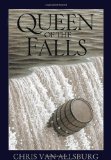
 QUEEN OF THE FALLS by Chris Van Allsburg (Houghton Mifflin)
QUEEN OF THE FALLS by Chris Van Allsburg (Houghton Mifflin)
The talented illustrator who has brought us classics like THE POLAR EXPRESS and JUMANJI
and JUMANJI  does not churn them out, but rather, delivers a gem every few years. In a departure from his usual fantastical fare, Van Allsburg turns his attention to a biographical story in which truth is stranger than fiction. In 1901, Annie Edison Taylor, a 62-year-old marm at a charm school, found her financial resources depleting and without any prospects for her old age. Fearing the poorhouse, she devises a daredevil stunt that verged on madness: to be the first to go over the drop of Niagara Falls in a barrel of her own special design, and then reap the benefits of subsequent fame on a tour circuit. But between nefarious managers and onlookers who are disappointed that Annie is more grandma than glamor-girl, the bumpy trip down the mountain of water is not all Annie will have to survive.
does not churn them out, but rather, delivers a gem every few years. In a departure from his usual fantastical fare, Van Allsburg turns his attention to a biographical story in which truth is stranger than fiction. In 1901, Annie Edison Taylor, a 62-year-old marm at a charm school, found her financial resources depleting and without any prospects for her old age. Fearing the poorhouse, she devises a daredevil stunt that verged on madness: to be the first to go over the drop of Niagara Falls in a barrel of her own special design, and then reap the benefits of subsequent fame on a tour circuit. But between nefarious managers and onlookers who are disappointed that Annie is more grandma than glamor-girl, the bumpy trip down the mountain of water is not all Annie will have to survive.
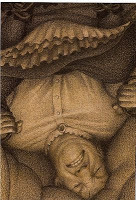 Van Allsburg's signature nostalgic sepia or black-and-grey pencil lines are especially befitting the turn-of-the-century feel, and the startlingly detailed expressions of the people are haunting and tell another story of a thousand words, hearkening back to his prowess in POLAR EXPRESS, each pose begging the question: what are they thinking? (Though I couldn't help wondering if a woman as modest as Annie would have appreciated Van Allsburg's uncomely depictions of her and her petticoats a-flying as she tumbled inside her barrel.) The double-paged spread of the vessel teetering at the fall's edge is genuinely suspenseful, and will literally have readers holding their breath. In turns fascinating and exciting, this outstanding read-aloud book captures the roiling falls and all of its harrowing height, but also the poignancy of the decision of this unlikely adventurer; from the lie Annie tells about her age that nobody really believes, her understated reply of "all righty" when the barrel is about to be cut from its rope and swept into the rapids, the injustices she suffers after the fall, and the pensive interview she gives to a reporter toward the end of her life, after musing over a memory of being a child and staring at the falls:
Van Allsburg's signature nostalgic sepia or black-and-grey pencil lines are especially befitting the turn-of-the-century feel, and the startlingly detailed expressions of the people are haunting and tell another story of a thousand words, hearkening back to his prowess in POLAR EXPRESS, each pose begging the question: what are they thinking? (Though I couldn't help wondering if a woman as modest as Annie would have appreciated Van Allsburg's uncomely depictions of her and her petticoats a-flying as she tumbled inside her barrel.) The double-paged spread of the vessel teetering at the fall's edge is genuinely suspenseful, and will literally have readers holding their breath. In turns fascinating and exciting, this outstanding read-aloud book captures the roiling falls and all of its harrowing height, but also the poignancy of the decision of this unlikely adventurer; from the lie Annie tells about her age that nobody really believes, her understated reply of "all righty" when the barrel is about to be cut from its rope and swept into the rapids, the injustices she suffers after the fall, and the pensive interview she gives to a reporter toward the end of her life, after musing over a memory of being a child and staring at the falls:
Also of interest:
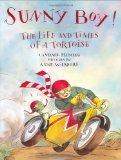 SUNNY BOY!: THE LIFE AND TIMES OF A TORTOISE
SUNNY BOY!: THE LIFE AND TIMES OF A TORTOISE by Candace Fleming, illustrated by Anne Wilsdorf (Farrar Straus Giroux)
by Candace Fleming, illustrated by Anne Wilsdorf (Farrar Straus Giroux)
When you live as long as a tortoise lives, you can expect a few owners. Sunny Boy lived as the pet of several agreeable, docile domesticators: a horticulturalist, a philatelist and a scholar, but ultimately falls into the hands of a daredevil bent on taking Sunny Boy with him on a descent over Niagara Falls in a barrel. Will he ever survive to live out his days in the lap of the little girl in the museum library to whom he feels more suitably matched? Based on actual, if unfortunate events (articulated beautifully in "The Truth Behind the Tale," an author's note at the story's finale), this genial and surprising story demonstrates a love of life, even with all its unexpected twists, turns, losses and leaks. (7 and up)
Links are provided for informational use. Don't forget to support your local bookseller.
More Esmé stuff at www.planetesme.com.


 QUEEN OF THE FALLS by Chris Van Allsburg (Houghton Mifflin)
QUEEN OF THE FALLS by Chris Van Allsburg (Houghton Mifflin)The talented illustrator who has brought us classics like THE POLAR EXPRESS
 and JUMANJI
and JUMANJI  does not churn them out, but rather, delivers a gem every few years. In a departure from his usual fantastical fare, Van Allsburg turns his attention to a biographical story in which truth is stranger than fiction. In 1901, Annie Edison Taylor, a 62-year-old marm at a charm school, found her financial resources depleting and without any prospects for her old age. Fearing the poorhouse, she devises a daredevil stunt that verged on madness: to be the first to go over the drop of Niagara Falls in a barrel of her own special design, and then reap the benefits of subsequent fame on a tour circuit. But between nefarious managers and onlookers who are disappointed that Annie is more grandma than glamor-girl, the bumpy trip down the mountain of water is not all Annie will have to survive.
does not churn them out, but rather, delivers a gem every few years. In a departure from his usual fantastical fare, Van Allsburg turns his attention to a biographical story in which truth is stranger than fiction. In 1901, Annie Edison Taylor, a 62-year-old marm at a charm school, found her financial resources depleting and without any prospects for her old age. Fearing the poorhouse, she devises a daredevil stunt that verged on madness: to be the first to go over the drop of Niagara Falls in a barrel of her own special design, and then reap the benefits of subsequent fame on a tour circuit. But between nefarious managers and onlookers who are disappointed that Annie is more grandma than glamor-girl, the bumpy trip down the mountain of water is not all Annie will have to survive.  Van Allsburg's signature nostalgic sepia or black-and-grey pencil lines are especially befitting the turn-of-the-century feel, and the startlingly detailed expressions of the people are haunting and tell another story of a thousand words, hearkening back to his prowess in POLAR EXPRESS, each pose begging the question: what are they thinking? (Though I couldn't help wondering if a woman as modest as Annie would have appreciated Van Allsburg's uncomely depictions of her and her petticoats a-flying as she tumbled inside her barrel.) The double-paged spread of the vessel teetering at the fall's edge is genuinely suspenseful, and will literally have readers holding their breath. In turns fascinating and exciting, this outstanding read-aloud book captures the roiling falls and all of its harrowing height, but also the poignancy of the decision of this unlikely adventurer; from the lie Annie tells about her age that nobody really believes, her understated reply of "all righty" when the barrel is about to be cut from its rope and swept into the rapids, the injustices she suffers after the fall, and the pensive interview she gives to a reporter toward the end of her life, after musing over a memory of being a child and staring at the falls:
Van Allsburg's signature nostalgic sepia or black-and-grey pencil lines are especially befitting the turn-of-the-century feel, and the startlingly detailed expressions of the people are haunting and tell another story of a thousand words, hearkening back to his prowess in POLAR EXPRESS, each pose begging the question: what are they thinking? (Though I couldn't help wondering if a woman as modest as Annie would have appreciated Van Allsburg's uncomely depictions of her and her petticoats a-flying as she tumbled inside her barrel.) The double-paged spread of the vessel teetering at the fall's edge is genuinely suspenseful, and will literally have readers holding their breath. In turns fascinating and exciting, this outstanding read-aloud book captures the roiling falls and all of its harrowing height, but also the poignancy of the decision of this unlikely adventurer; from the lie Annie tells about her age that nobody really believes, her understated reply of "all righty" when the barrel is about to be cut from its rope and swept into the rapids, the injustices she suffers after the fall, and the pensive interview she gives to a reporter toward the end of her life, after musing over a memory of being a child and staring at the falls: Be sure to share this unusual piece of history with middle elementary children and ask why Annie made the decisions she did, because with an aging population, a suffering economy and lack of public health care, this book about an event a hundred years ago is sure to inspire some timely discussion today. It seems that growing older may be the bravest trick of all. Author video and general info about the falls here. (8 and up)"I stood here with my father, in this very spot. I'd never seen anything like that waterfall. It looked like the end of the world, dreadful and beautiful, all at once. My father took my hand and asked if I was frightened. I told him I was, then asked if we could get closer...That's what everyone wonders when they see Niagara...How close will their courage let them get to it? Well, sir, you can't get any closer than I got."
Also of interest:
 SUNNY BOY!: THE LIFE AND TIMES OF A TORTOISE
SUNNY BOY!: THE LIFE AND TIMES OF A TORTOISE by Candace Fleming, illustrated by Anne Wilsdorf (Farrar Straus Giroux)
by Candace Fleming, illustrated by Anne Wilsdorf (Farrar Straus Giroux)When you live as long as a tortoise lives, you can expect a few owners. Sunny Boy lived as the pet of several agreeable, docile domesticators: a horticulturalist, a philatelist and a scholar, but ultimately falls into the hands of a daredevil bent on taking Sunny Boy with him on a descent over Niagara Falls in a barrel. Will he ever survive to live out his days in the lap of the little girl in the museum library to whom he feels more suitably matched? Based on actual, if unfortunate events (articulated beautifully in "The Truth Behind the Tale," an author's note at the story's finale), this genial and surprising story demonstrates a love of life, even with all its unexpected twists, turns, losses and leaks. (7 and up)
Links are provided for informational use. Don't forget to support your local bookseller.
More Esmé stuff at www.planetesme.com.
Published on April 05, 2011 19:16
March 1, 2011
FLESH & BLOOD SO CHEAP (NONFICTION)

 FLESH & BLOOD SO CHEAP: THE TRIANGLE FIRE AND ITS LEGACY by Albert Marrin (Knopf, 2011)
FLESH & BLOOD SO CHEAP: THE TRIANGLE FIRE AND ITS LEGACY by Albert Marrin (Knopf, 2011)
In these pages, we follow the arrival of 19th century immigrants past the Statue of Liberty and into the ghettos of New York City, where some would find employment with the notorious Triangle Shirtwaist Factory. Demonstrations to draw attentions to poor working conditions failed; protesters were beaten down and then returned to work, only to have their complaints written into the annals of history in a fire where one hundred and forty-six unfortunate workers lost their lives in most terrible ways. A plethora of maps, photographs, primary source materials and related sidelines (autobiographical material about Jacob Riis, "sweatshop steps in making a cotton garment") bring the past to life, offering a steady flow of historical detail that emphasize the humanity of the situation and keep the topic from becoming solely a sensational retelling of a disaster ("the story of the Triangle fire is not the story of one accidental moment in time. It is the story of immigration and the hard work necessary to make it in a new country..."). The text is generous in an amount that may be overwhelming for some readers, but the columnar layout makes it more manageable, and the material is engaging, told in almost a play-by-play fashion that pulls no punches, with conversational, age-appropriate explanations throughout. With the hundredth anniversary of the fire upon us on March 25th (and a PBS program already aired), this book does great honor to the ghosts of that tragedy, and while it is a serious subject for young readers, it is worth keeping in mind that child labor is their history, too. Notes and index are included; the care that went into the book's creation is clearly scholarly. If you know a young reader interested in the subject, this book is the most thorough, and if you know any child interested in the history of the American people, this book is most outstanding. (10 and up)
Also of interest:No doubt, the kiddies are hearing the word "union" and "strike" bandied about more than usual these days, the news buzzing about Wisconsin state workers' recent demonstrations against Governor Scott Walker. Here's a pick that helps children to understand what a strike and a union are, in the context of children's history!
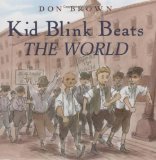 KID BLINKS BEATS THE WORLD by Don Brown (Roaring Brook)
KID BLINKS BEATS THE WORLD by Don Brown (Roaring Brook)
 In 1899, it was not uncommon for boys to work as "newsies," peddling the consignment copies of newspapers published by millionaires Hearst and Pulitzer. When those magnates decided to charge an extra penny against their workers' wages, this was more than the little boys could bear. "I'm trying to figure how ten cents on a hundred papers can mean more to a millionaire than it does to newsboys," Kid Blink tried to figure. "If they can't spare it, how can we?" So begins the wa r between the newsies and the moguls, and a war it is, complete with protests, battles, leaders and ploys, many led by surprisingly articulate and earnest children. Peppery dialects and sobering history help to bring this early union battle to life in sepia tones. You wouldn't go wrong to share every one of Don Brown's wonderful picture book biographies with children, always affecting, but this one packs a special punch. Youths of our day will surely be inspired by Kid Blink's righteous indignation and awed by his bravery…can you imagine a child speaking his heart to a mob of five thousand? It was done. (6 and up)
In 1899, it was not uncommon for boys to work as "newsies," peddling the consignment copies of newspapers published by millionaires Hearst and Pulitzer. When those magnates decided to charge an extra penny against their workers' wages, this was more than the little boys could bear. "I'm trying to figure how ten cents on a hundred papers can mean more to a millionaire than it does to newsboys," Kid Blink tried to figure. "If they can't spare it, how can we?" So begins the wa r between the newsies and the moguls, and a war it is, complete with protests, battles, leaders and ploys, many led by surprisingly articulate and earnest children. Peppery dialects and sobering history help to bring this early union battle to life in sepia tones. You wouldn't go wrong to share every one of Don Brown's wonderful picture book biographies with children, always affecting, but this one packs a special punch. Youths of our day will surely be inspired by Kid Blink's righteous indignation and awed by his bravery…can you imagine a child speaking his heart to a mob of five thousand? It was done. (6 and up) Also, check out COUNTING ON GRACE
Also, check out COUNTING ON GRACE by Elizabeth Winthrop (Dell Yearling)
by Elizabeth Winthrop (Dell Yearling)  If you are into American history at all, you know the photograph: a weary young girl standing in front of rows of bobbins, a smock askew, hair pulled up, leaning on one elbow, a child pausing from her twelve hour workday. This moment captured in black and white by artist, social reformer and advocate Lewis Hine was the inspiration for Elizabeth Winthrop's latest historical novel.
If you are into American history at all, you know the photograph: a weary young girl standing in front of rows of bobbins, a smock askew, hair pulled up, leaning on one elbow, a child pausing from her twelve hour workday. This moment captured in black and white by artist, social reformer and advocate Lewis Hine was the inspiration for Elizabeth Winthrop's latest historical novel.Grace and her best friend Arthur are forced to leave school to work in a mill, replacing full bobbins with empty ones. Grace is glad to have the chance to earn some extra pennies for her family, who depend on this contribution for their very survival. When a teacher encourages the children to write a letter of complaint to the National Labor Committee, Grace understands that outcomes of such an action could put her family in terrible jeopardy. Arthur, however, cannot bear the conditions in the mill. He sees opportunity in education and he is willing to do anything to get it, even if it means purposely mangling his hand in a machine. It seems the work of Lewis Hine has come too late for some. The experiences of the people around her, however painful, lead Grace to make a stunning choice about the path of her own life.
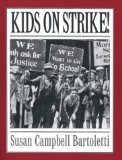
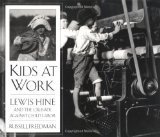 There are so many strong points about this novel. One is the tension. We care about all the characters, and every one of their choices reverberates in the lives of those they love. It is a powerful thing to read, as a child, the impact of decisions upon others in ways we don't expect. The situations, though painful, are done realistically, and convey the conflict of child labor so very powerfully in the context of the character's place and time. Which brings us to the research, which lends both believability and flavor to the prose and does just what good historical fiction should do: carry us away, make us feel as if we are there. The inclusion of Lewis Hine as a character in the story will lead children to delve deeper, in books like KIDS AT WORK: LEWIS HINE AND THE HISTORY OF CHILD LABOR
There are so many strong points about this novel. One is the tension. We care about all the characters, and every one of their choices reverberates in the lives of those they love. It is a powerful thing to read, as a child, the impact of decisions upon others in ways we don't expect. The situations, though painful, are done realistically, and convey the conflict of child labor so very powerfully in the context of the character's place and time. Which brings us to the research, which lends both believability and flavor to the prose and does just what good historical fiction should do: carry us away, make us feel as if we are there. The inclusion of Lewis Hine as a character in the story will lead children to delve deeper, in books like KIDS AT WORK: LEWIS HINE AND THE HISTORY OF CHILD LABOR by Russell Freedman (Clarion) and KIDS ON STRIKE!
by Russell Freedman (Clarion) and KIDS ON STRIKE! by Susan Campbell Bartoletti (Houghton Mifflin). And the last great feat of this book is voice, which she has given to this Vermont farmgirl faced with the need to do the right thing in the face of contradictions. If you enjoyed the bold candor of the period writing in Jennifer Holm's
by Susan Campbell Bartoletti (Houghton Mifflin). And the last great feat of this book is voice, which she has given to this Vermont farmgirl faced with the need to do the right thing in the face of contradictions. If you enjoyed the bold candor of the period writing in Jennifer Holm's  OUR ONLY MAY AMELIA,
OUR ONLY MAY AMELIA, you will love Grace's genial, colloquial point of view as well. I'm very excited for author Elizabeth Winthrop, who gained acclaim for her unique mix of fantasy and historical fiction (CASTLE IN THE ATTIC
you will love Grace's genial, colloquial point of view as well. I'm very excited for author Elizabeth Winthrop, who gained acclaim for her unique mix of fantasy and historical fiction (CASTLE IN THE ATTIC ). With over fifty books under her belt, her work is stronger than ever. This is a special contribution to the shelves of children's literature, and offers children a first-person view into their own history. (10 and up)
). With over fifty books under her belt, her work is stronger than ever. This is a special contribution to the shelves of children's literature, and offers children a first-person view into their own history. (10 and up)Links are provided for informational use. Don't forget to support your local bookseller.
More Esmé stuff at www.planetesme.com.
Published on March 01, 2011 14:47
February 28, 2011
A DONKEY READS (PICTURE BOOK)
PICTURE BOOK
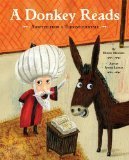 A DONKEY READS by Muriel Mandell, illustrated by André Letria (Star Bright, 2011)
A DONKEY READS by Muriel Mandell, illustrated by André Letria (Star Bright, 2011)

A tyrannical Mongol leader demands tribute from all the residents of an Anatolian village, but one poor family fears their only possible offering, the family donkey, may inspire insult. Indeed, the despot flies off the handle with the first hee-haw, but is placated by the village wise man, Nasreddin Hoca, who insists that the donkey's "intelligent eyes" indicate that he can be taught to read. By feeding the donkey barley between the pages of the book, he manages a most clever trick that hopefully will save the hides of the unfortunate clan. This is a must-have for anyone who enjoys a good trickster tale, or as a stand-out to add to the increasingly expanding children's bookshelf on the theme of reading (recently: DOG LOVES BOOKS by Louise Yates, THE WONDERFUL BOOK by Leonid Gore, READ TO TIGER
by Louise Yates, THE WONDERFUL BOOK by Leonid Gore, READ TO TIGER by S.J. Fore, and the deservedly popular HOW ROCKET LEARNED TO READ
by S.J. Fore, and the deservedly popular HOW ROCKET LEARNED TO READ by Tad Hills). Thickly painted illustrations have heft and are extremely expressive, and add a lighthearted dimension to a suspenseful folktale. Smart, funny, provocative and inimitably surprising, this legend of Nasreddin Hoca has survived over seven hundred years, and with good reason; it is as much of a pleasure to share today as it must have been centuries ago. (5 and up)
by Tad Hills). Thickly painted illustrations have heft and are extremely expressive, and add a lighthearted dimension to a suspenseful folktale. Smart, funny, provocative and inimitably surprising, this legend of Nasreddin Hoca has survived over seven hundred years, and with good reason; it is as much of a pleasure to share today as it must have been centuries ago. (5 and up)
Also of interest:Just getting to know Nasreddin, the Aesop of Turkey? Try this one, too:
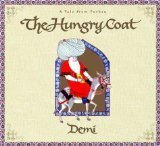 THE HUNGRY COAT
THE HUNGRY COAT
 by Demi (McElderberry) Nasrettin (spelling variation) is invited to dinner, but is rudely shunned by guests and host alike. Could it be his shabby attire? He slips away, returning in magnificent garb, and is welcomed warmly. When served his dinner, though, he proceeds to feed his coat! There is a lesson about appearances hidden in the lining of Nasrettin's strange behavior, one that readers will not likely soon forget. The great Islamic folk hero and champion of common sense gets his due in Demi's signature style: small, jeweled figures surrounded by swirling borders and motifs and touched with gold. This serious topic is told with good humor and cleverness, making this a sensational read-aloud that every child (and grown-up) will benefit from hearing, and one that will whet readers' appetites for even more of Nasrettin's timeless fables. (6 and up)
by Demi (McElderberry) Nasrettin (spelling variation) is invited to dinner, but is rudely shunned by guests and host alike. Could it be his shabby attire? He slips away, returning in magnificent garb, and is welcomed warmly. When served his dinner, though, he proceeds to feed his coat! There is a lesson about appearances hidden in the lining of Nasrettin's strange behavior, one that readers will not likely soon forget. The great Islamic folk hero and champion of common sense gets his due in Demi's signature style: small, jeweled figures surrounded by swirling borders and motifs and touched with gold. This serious topic is told with good humor and cleverness, making this a sensational read-aloud that every child (and grown-up) will benefit from hearing, and one that will whet readers' appetites for even more of Nasrettin's timeless fables. (6 and up)
Links are provided for informational use. Don't forget to support your local bookseller.
More Esmé stuff at www.planetesme.com.

 A DONKEY READS by Muriel Mandell, illustrated by André Letria (Star Bright, 2011)
A DONKEY READS by Muriel Mandell, illustrated by André Letria (Star Bright, 2011)

A tyrannical Mongol leader demands tribute from all the residents of an Anatolian village, but one poor family fears their only possible offering, the family donkey, may inspire insult. Indeed, the despot flies off the handle with the first hee-haw, but is placated by the village wise man, Nasreddin Hoca, who insists that the donkey's "intelligent eyes" indicate that he can be taught to read. By feeding the donkey barley between the pages of the book, he manages a most clever trick that hopefully will save the hides of the unfortunate clan. This is a must-have for anyone who enjoys a good trickster tale, or as a stand-out to add to the increasingly expanding children's bookshelf on the theme of reading (recently: DOG LOVES BOOKS
 by Louise Yates, THE WONDERFUL BOOK by Leonid Gore, READ TO TIGER
by Louise Yates, THE WONDERFUL BOOK by Leonid Gore, READ TO TIGER by S.J. Fore, and the deservedly popular HOW ROCKET LEARNED TO READ
by S.J. Fore, and the deservedly popular HOW ROCKET LEARNED TO READ by Tad Hills). Thickly painted illustrations have heft and are extremely expressive, and add a lighthearted dimension to a suspenseful folktale. Smart, funny, provocative and inimitably surprising, this legend of Nasreddin Hoca has survived over seven hundred years, and with good reason; it is as much of a pleasure to share today as it must have been centuries ago. (5 and up)
by Tad Hills). Thickly painted illustrations have heft and are extremely expressive, and add a lighthearted dimension to a suspenseful folktale. Smart, funny, provocative and inimitably surprising, this legend of Nasreddin Hoca has survived over seven hundred years, and with good reason; it is as much of a pleasure to share today as it must have been centuries ago. (5 and up)Also of interest:Just getting to know Nasreddin, the Aesop of Turkey? Try this one, too:
 THE HUNGRY COAT
THE HUNGRY COAT
 by Demi (McElderberry) Nasrettin (spelling variation) is invited to dinner, but is rudely shunned by guests and host alike. Could it be his shabby attire? He slips away, returning in magnificent garb, and is welcomed warmly. When served his dinner, though, he proceeds to feed his coat! There is a lesson about appearances hidden in the lining of Nasrettin's strange behavior, one that readers will not likely soon forget. The great Islamic folk hero and champion of common sense gets his due in Demi's signature style: small, jeweled figures surrounded by swirling borders and motifs and touched with gold. This serious topic is told with good humor and cleverness, making this a sensational read-aloud that every child (and grown-up) will benefit from hearing, and one that will whet readers' appetites for even more of Nasrettin's timeless fables. (6 and up)
by Demi (McElderberry) Nasrettin (spelling variation) is invited to dinner, but is rudely shunned by guests and host alike. Could it be his shabby attire? He slips away, returning in magnificent garb, and is welcomed warmly. When served his dinner, though, he proceeds to feed his coat! There is a lesson about appearances hidden in the lining of Nasrettin's strange behavior, one that readers will not likely soon forget. The great Islamic folk hero and champion of common sense gets his due in Demi's signature style: small, jeweled figures surrounded by swirling borders and motifs and touched with gold. This serious topic is told with good humor and cleverness, making this a sensational read-aloud that every child (and grown-up) will benefit from hearing, and one that will whet readers' appetites for even more of Nasrettin's timeless fables. (6 and up)Links are provided for informational use. Don't forget to support your local bookseller.
More Esmé stuff at www.planetesme.com.
Published on February 28, 2011 10:56
February 17, 2011
I'M NOT (PICTURE BOOK)
PICTURE BOOK
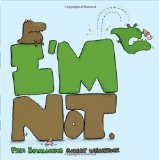 I'M NOT by Pam Smallcomb, illustrated by Robert Weinstock (Schwartz & Wade, 2011)
I'M NOT by Pam Smallcomb, illustrated by Robert Weinstock (Schwartz & Wade, 2011)

Also of interest: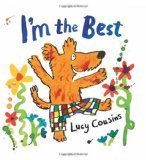 The other side of the coin? Well-meaning but only partial redemption of a picture book narcissist may be found in Lucy Cousin's I'M THE BEST, in which a doggy has to find a balance between his own self-esteem and a recognition of what's best about his buddies, a bit of a throwback to Marjorie Weinman Sharmat and Kay Chorao's 1970's gold star picture book, I'M TERRIFIC
The other side of the coin? Well-meaning but only partial redemption of a picture book narcissist may be found in Lucy Cousin's I'M THE BEST, in which a doggy has to find a balance between his own self-esteem and a recognition of what's best about his buddies, a bit of a throwback to Marjorie Weinman Sharmat and Kay Chorao's 1970's gold star picture book, I'M TERRIFIC
 , in which a little bear rewards himself prolifically for his greatness, while his friends struggle to get him in check.
, in which a little bear rewards himself prolifically for his greatness, while his friends struggle to get him in check.
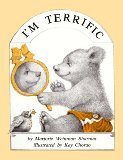 Speaking of terrific, and if you like these kind of themes, are you familiar with one of my new favorite blogs, BOOKS THAT HEAL KIDS? I am not a fan of bibliotherapy per se, as I consider all well-written children's books to be character-building, and I am fearful about navigating through shelves of books written with issues in mind instead of children. But to my hesitation, this site says too-shay! I can't resist these thoughtful and sensitive selections, so brilliantly reviewed. Check it out!
Speaking of terrific, and if you like these kind of themes, are you familiar with one of my new favorite blogs, BOOKS THAT HEAL KIDS? I am not a fan of bibliotherapy per se, as I consider all well-written children's books to be character-building, and I am fearful about navigating through shelves of books written with issues in mind instead of children. But to my hesitation, this site says too-shay! I can't resist these thoughtful and sensitive selections, so brilliantly reviewed. Check it out!
Links are provided for informational use. Don't forget to support your local bookseller.
More Esmé stuff at www.planetesme.com.

 I'M NOT by Pam Smallcomb, illustrated by Robert Weinstock (Schwartz & Wade, 2011)
I'M NOT by Pam Smallcomb, illustrated by Robert Weinstock (Schwartz & Wade, 2011)

If Evelyn was a book, you'd read her all night under the covers to see what happens next...This book focuses realistically (as you can be with amphibians wearing hair bows) and hilariously on a little alligator girl's quest to discover what she might possibly be that could shine alongside the many talents and feats of her companion, feeling rather inadequate all the while. Luckily, the narrator is something Evelyn can't be: a true blue friend for Evelyn, and the last pages sing: "I am! I am! I am!" At first, I was a little lukewarm about the wan, poop-colored cover, but once a few pages were turned, it only added to the humor; stylistically, somebody read a lot of James Marshall. A natural part of child development is discovering what you're good at (or not), and many children going through that self-deprecating stage, or prone to unnecessary comparisons with peers, will discover some very heartening perspective within these pages. Stop laughing? I'm not. (5 and up)
When Evelyn comes over, she changes my room, my scales, my worm.
She's a wonderful decorator. I'm not...
Evelyn is lots o things.
Circus performer.
I'm not.
Antarctic explorer.
I'm not.
Queen of England.
I'm not...I'm not...I'm not.
Also of interest:
 The other side of the coin? Well-meaning but only partial redemption of a picture book narcissist may be found in Lucy Cousin's I'M THE BEST, in which a doggy has to find a balance between his own self-esteem and a recognition of what's best about his buddies, a bit of a throwback to Marjorie Weinman Sharmat and Kay Chorao's 1970's gold star picture book, I'M TERRIFIC
The other side of the coin? Well-meaning but only partial redemption of a picture book narcissist may be found in Lucy Cousin's I'M THE BEST, in which a doggy has to find a balance between his own self-esteem and a recognition of what's best about his buddies, a bit of a throwback to Marjorie Weinman Sharmat and Kay Chorao's 1970's gold star picture book, I'M TERRIFIC
 , in which a little bear rewards himself prolifically for his greatness, while his friends struggle to get him in check.
, in which a little bear rewards himself prolifically for his greatness, while his friends struggle to get him in check.  Speaking of terrific, and if you like these kind of themes, are you familiar with one of my new favorite blogs, BOOKS THAT HEAL KIDS? I am not a fan of bibliotherapy per se, as I consider all well-written children's books to be character-building, and I am fearful about navigating through shelves of books written with issues in mind instead of children. But to my hesitation, this site says too-shay! I can't resist these thoughtful and sensitive selections, so brilliantly reviewed. Check it out!
Speaking of terrific, and if you like these kind of themes, are you familiar with one of my new favorite blogs, BOOKS THAT HEAL KIDS? I am not a fan of bibliotherapy per se, as I consider all well-written children's books to be character-building, and I am fearful about navigating through shelves of books written with issues in mind instead of children. But to my hesitation, this site says too-shay! I can't resist these thoughtful and sensitive selections, so brilliantly reviewed. Check it out!Links are provided for informational use. Don't forget to support your local bookseller.
More Esmé stuff at www.planetesme.com.
Published on February 17, 2011 18:35
February 12, 2011
JUST BEING AUDREY (NONFICTION)
NONFICTION
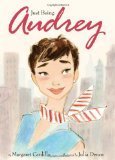 JUST BEING AUDREY by Margaret Cardillo, illustrated by Julia Denos (Balzer & Bray, 2011)
JUST BEING AUDREY by Margaret Cardillo, illustrated by Julia Denos (Balzer & Bray, 2011)

Her mother reminded her that there were more important things than fame..."You must always be kind."Talk about a duckling growing into a swan! From Audrey Hepburn's childhood beginnings as a gawky girl in ballet class, hiding with family during WWII, to her adventures in acting (meeting the author Colette and cast as Gigi, and landing a role in Roman Holiday), to her other roles in life as a mother and as a UNICEF goodwill ambassador, the life of a woman who knew how to be her own unique brave and endearing self is laid out to inspire a whole new generation. I am simply beside myself over the illustrations as lovely as a 1950's back-issue of Vogue; the double-page spread of Audreys all bedeckled in beautiful vintage Hollywood fashion from Funny Face to Breakfast at Tiffany's to My Fair Lady is sure to elicit groans of admiration, and the high-spirited smile Audrey wears as she dons one scarf four different ways is utterly contagious. The illustrator's style is spry, carrying us easily across the whirlwind timeline and aging our pixie queen most gracefully. While the fashionista that is Audrey is undeniable in these pages, the biography is not shallow, sharing insights and highlights of a real life and bringing it around nicely at the end, with a collection of sweet modern-day girls emulating her style. All I can say is: more! More! More! Gene Kelly biography next, please...and thank you. (6 and up)
Also of interest:In Audrey Hepburn's honor, a clip from Funny Face
 , accompanied by Kay Thompson (who is also the author of Eloise
, accompanied by Kay Thompson (who is also the author of Eloise ):
):Links are provided for informational use. Don't forget to support your local bookseller.
More Esmé stuff at www.planetesme.com.
Published on February 12, 2011 17:17
February 6, 2011
FORTUNE COOKIES (PICTURE BOOK)
 FORTUNE COOKIES
FORTUNE COOKIES
 by Albert Bitterman, illustrated by Chris Raschka (Beach Lane, 2011)
by Albert Bitterman, illustrated by Chris Raschka (Beach Lane, 2011) On Monday my fortune said: Money is like the wind.
And guess what?
I found a dollar under my pillow!
On Tuesday my fortune said: Try to find the good with the bad.
And guess what?
I lost my kite, but...I found a cat.
A week's worth of fortune cookies tell a homey story with a happily every after and a twist at the end. Pull tabs add interest to the concept, allowing each fortune to be tugged from it's fold, and the Caldecott-winning illustrator is in top form, with tight, boxy packaging nicely framing Raschka's wide-brush flourishes. Children's lit enthusiasts may recognize the name Al Bitterman as the author of the snarky and insightful reviews coming out of Reading Reptile, pretty much the greatest children's bookstore in the country. Bitterman is the pseudonym of the mighty Pete Cowdin, one of the store's owners, a guy who really knows what children like to read. He proved it by his inventory, and now, he proves it in his own book. Of course, there are tons of teacher-ly extensions: Chinese New Year, DIY fortune cookies where children write their own forecasts (haiku fortune cookies work nicely for National Poetry Month), or just a fun storytime with a treat at the end. Not since a cootie-catcher has telling the future been so much fun. Your fortune: Good books lead to good readers. You take it from there. (4 and up)
Also of interest:I see a storytime in your future.
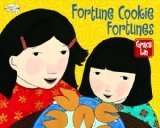 FORTUNE COOKIE FORTUNES
FORTUNE COOKIE FORTUNES
 by Grace Lin (Knopf) Isn't it funny how fortunes always seem to come true? After dinner at a Chinese restaurant, an observant little girl notices how the slip in each relative's cookie matches their circumstance. Lest we forget that this award-winning author (WHERE THE MOUNTAIN MEETS THE MOON
by Grace Lin (Knopf) Isn't it funny how fortunes always seem to come true? After dinner at a Chinese restaurant, an observant little girl notices how the slip in each relative's cookie matches their circumstance. Lest we forget that this award-winning author (WHERE THE MOUNTAIN MEETS THE MOON , THE YEAR OF THE DOG
, THE YEAR OF THE DOG , LING AND TING, NOT EXACTLY THE SAME!
, LING AND TING, NOT EXACTLY THE SAME! ) is also a proficient illustrator, the pictures are particularly eye-catching, brilliant in color and featuring double-paged spreads with fetching patterned backgrounds. The story ends with some real history of the fortune cookie with its Asian inspiration and American birth, and an illustration of one split apart in the reader's honor: "you have just read a good book." Yummy! (5 and up)
) is also a proficient illustrator, the pictures are particularly eye-catching, brilliant in color and featuring double-paged spreads with fetching patterned backgrounds. The story ends with some real history of the fortune cookie with its Asian inspiration and American birth, and an illustration of one split apart in the reader's honor: "you have just read a good book." Yummy! (5 and up)Links are provided for informational use. Don't forget to support your local bookseller.
More Esmé stuff at www.planetesme.com.
Published on February 06, 2011 11:49
January 27, 2011
BROWNIE GROUNDHOG AND THE FEBRUARY FOX (PICTURE BOOK)
PICTURE BOOK
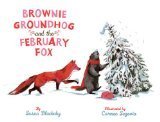 BROWNIE GROUNDHOG AND THE FEBRUARY FOX by Susan Blackaby, illustrated by Carmen Segovia (Sterling, 2011)
BROWNIE GROUNDHOG AND THE FEBRUARY FOX by Susan Blackaby, illustrated by Carmen Segovia (Sterling, 2011)

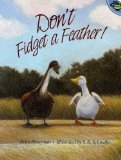 Also of interest:
Also of interest:
A ridiculous amount of Groundhog Day books here.
And if you'd like more fox-on-animal action, tune into DON'T FIDGET A FEATHER by Erica Silverman, illustrated by S.D. Schindler (Aladdin),
by Erica Silverman, illustrated by S.D. Schindler (Aladdin),  an exciting and laugh-out-loud tale of a "freeze-in-place" contest between a very competitive Gander and Duck that goes dangerously awry when a hungry fox shows up. Move, Gander, move!!! The message is clear: sometimes there's something more important at stake then winning. I like a book that impels children to scream really loudly while you read, that means it's a good story. Wear your earplugs.
an exciting and laugh-out-loud tale of a "freeze-in-place" contest between a very competitive Gander and Duck that goes dangerously awry when a hungry fox shows up. Move, Gander, move!!! The message is clear: sometimes there's something more important at stake then winning. I like a book that impels children to scream really loudly while you read, that means it's a good story. Wear your earplugs.
Links are provided for informational use. Don't forget to support your local bookseller.
More Esmé stuff at www.planetesme.com.

 BROWNIE GROUNDHOG AND THE FEBRUARY FOX by Susan Blackaby, illustrated by Carmen Segovia (Sterling, 2011)
BROWNIE GROUNDHOG AND THE FEBRUARY FOX by Susan Blackaby, illustrated by Carmen Segovia (Sterling, 2011)

"Don't be silly," said Brownie, wiggling free. "You're too late for breakfast."A friendship is hard-won as a groundhog moves from prey to precious in the eyes of a hungry fox. Having come out into the open to check his shadow, Brownie is pounced upon by a novice predator who is easily talked out of and tricked out of a meal. When Brownie finally manages to tie the fox to a tree with a red scarf, maybe the fox has learned his lesson, or at least, Brownie's suffered from some mild form of Stockholm Syndrome. What is freaky and ultimately irresistible about this book is the animals, for all of their human banter, are really quite animal-like, sweet and stupid and aggressive in turns...and always down for a good meal. Wintry illustrations with a thoughtful limited palette of burnt umber, white and blue paint are both pretty and fun to look at, featuring figures that mix postures both people-like and very, very canine. Above all, there is something very direct and naturalistic about this story, and children will appreciate the honesty of that bite.
"Really?" the fox frowned. "What about lunch?"
"Too early," said Brownie. "You'll just have to wait."
"I hate waiting," said the fox.
"I know what you mean," said Brownie.
 Also of interest:
Also of interest:A ridiculous amount of Groundhog Day books here.
And if you'd like more fox-on-animal action, tune into DON'T FIDGET A FEATHER
 by Erica Silverman, illustrated by S.D. Schindler (Aladdin),
by Erica Silverman, illustrated by S.D. Schindler (Aladdin),  an exciting and laugh-out-loud tale of a "freeze-in-place" contest between a very competitive Gander and Duck that goes dangerously awry when a hungry fox shows up. Move, Gander, move!!! The message is clear: sometimes there's something more important at stake then winning. I like a book that impels children to scream really loudly while you read, that means it's a good story. Wear your earplugs.
an exciting and laugh-out-loud tale of a "freeze-in-place" contest between a very competitive Gander and Duck that goes dangerously awry when a hungry fox shows up. Move, Gander, move!!! The message is clear: sometimes there's something more important at stake then winning. I like a book that impels children to scream really loudly while you read, that means it's a good story. Wear your earplugs. Links are provided for informational use. Don't forget to support your local bookseller.
More Esmé stuff at www.planetesme.com.
Published on January 27, 2011 19:41
Esmé Raji Codell's Blog
- Esmé Raji Codell's profile
- 148 followers
Esmé Raji Codell isn't a Goodreads Author
(yet),
but they
do have a blog,
so here are some recent posts imported from
their feed.



